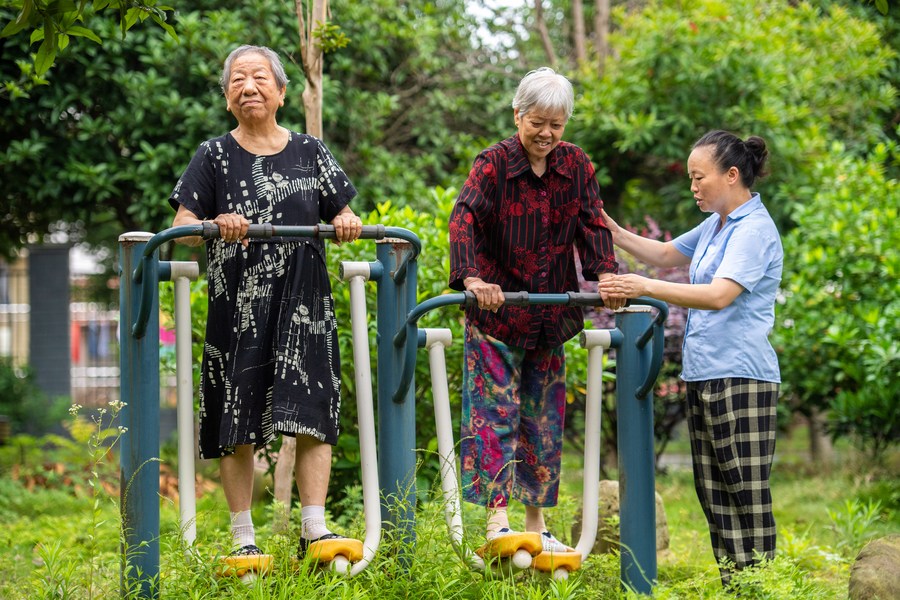
Senior residents exercise with the help of a staff member at a social welfare center in Hanshou County of Changde City, central China's Hunan Province, June 20, 2023. (Xinhua/Chen Sihan)
BEIJING, July 6 -- Wang Jumin, 87, is among the army of Chinese retirees who have flocked to the coastal city of Weihai in Shandong Province to spend their golden years.
With a rapidly aging population and an impressive average life expectancy of 81.56 years, Weihai stands as a leading example of proactive elderly care prioritizing the well-being and support of its senior citizens.
"Elderly care institutions here house hospitals within their walls and they are linked to the national medical insurance network. This integration ensures that we can rest easy, knowing doctors are just a stone's throw away, providing daily visits and medical consultations," Wang said.
Through innovative approaches such as public-private partnerships and government assistance, the city has built a total of 162 elderly care institutions.
Official data showed that China's population aged 60 and above had reached 280 million by the end of 2022.
China has pursued a proactive national strategy in response to its aging population. Effective initiatives have been taken to tackle demographic shifts in the country that are marked by low fertility, population aging, and regional variations in population growth and decline.
IMPROVED SERVICES
To date, more than 400 Chinese cities have formulated plans to offer integrated elderly and children care solutions.
In late June, a website was launched to facilitate easy access to elderly care services for seniors in Beijing. The website provides information on 574 registered elderly care institutions and 1,469 elderly care centers available in the city.
Beijing has witnessed a surge in the elderly population aged 80 and above over the past decade. Data revealed that this age group represented a record high of 4.9 percent of the total registered population in the city in 2022.
As one of the prominent challenges posed by an aging population, old-age support for those with disabilities has been a priority for policymakers in China.
According to official data, the number of elderly with disability and dementia in China reached 45 million by 2021. This group has been prioritized in the country's long-term care insurance system which was launched on a trial basis in 2016.
Granny Sun, a resident of Shanghai, and her husband are beneficiaries of the insurance system, which mainly provides basic living and medical care as well as provides fiscal subsidies for recipients.
The couple, having difficulties in undertaking daily living activities, now receive in-home services from a designated caregiver twice a week.
By 2022, trials for long-term care insurance have been carried out in 49 Chinese cities, covering more people like Sun and ensuring a better life for those in need.
HIGH-QUALITY DEVELOPMENT
After working in Shanghai for three years, Sheng Hanqi, 29, returned to his hometown Rudong County in Jiangsu Province four years ago and began working in the public relations department of a pulp and paper company under the Sinar Mas Group.
"I came home to take care of my grandparents who are over 80 years old. I didn't expect to have an opportunity to pursue my career in such a large company with global influence," Sheng said.
A county where the elderly account for over 30 percent of its total population of 880,000, Rudong has gained fresh vitality following the introduction of large industrial projects in sectors like new energy, biomedicine and semiconductor.
In the past three years, Rudong has attracted 57 projects worth more than 1 billion yuan each, with their total investment reaching 93.85 billion yuan (about 13.04 billion U.S. dollars). The county's GDP exceeded 130 billion yuan in 2022.
"High-quality development is the key to confronting the challenges of the aging problem head-on," said Rudong's Party chief Chen Huiyu.
"Only by maintaining a sound momentum of development can we offer high-level public services and attract qualified people to drive innovation and business startups," Chen said.
Under a plan to rivet talent, Rudong has brought in nearly 50 high-level innovative talents and around 4,000 college graduates every year.
Rudong has implemented stimulus measures to enhance the appeal for professional and technical personnel, which include providing a wide range of subsidies. The migrant population of an economic development zone in the county's Yangkou Port alone has exceeded 20,000.











